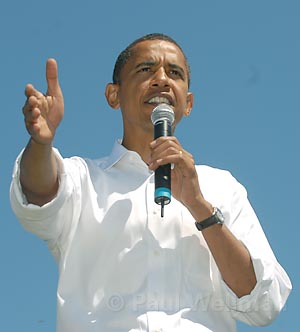UCSB Web Site Analyzes Obama’s First 100 Days
Compares Current Presidency Against Those of Past American Heads of State
Political pundits around the world are scrutinizing President Barack Obama‘s first 100 days in office. They can compare Obama’s activity to other U.S. presidents of the “modern” era – considered 1933 to the present – who took office following a partisan change in administration with a new feature on UCSB’s American Presidency Project Web site. John Woolley and Gerhard Peters, co-founders of the website, added the new feature, in part, because of the enthusiasm among the public and media for knowledge about what makes Obama’s administration distinct and for analysis of presidential behavior in general.

“An atmosphere of crisis presents possibility for innovation, for changes in public policy that are large and unique,” said Woolley, professor and department chair of political science at UCSB. “It is clear that, with the massive stimulus bill Obama got through Congress so quickly, [his first 100 days] will be a very productive period.”
According to the American Presidency Project, Obama has issued 16 executive orders, 11 memoranda, and three proclamations in his first 37 days in office, thus taking the lead in the use of unilateral action among his predecessors (30 actions, as compared to an average of 14.5). Among the comparison group, which includes Franklin Delano Roosevelt (1933), Dwight D. Eisenhower (1953), John F. Kennedy (1961), Jimmy Carter (1977), Richard Nixon (1969), Ronald Reagan (1981), Bill Clinton (1993), and George W. Bush (2001), Obama was second only to Bush in the number of days after taking office to visit a foreign country. Although Obama has made more public appearances at which he has made “remarks” than others in the comparison group, he was among the slowest incoming presidents to address the nation as a whole.
“One thing that drives presidential behavior during a post-election partisan change might be the need to fulfill campaign promises,” said Peters, a former UCSB political science graduate student who is now a professor at Citrus College in San Gabriel Valley. “Obama is certainly driven, in part, by that fact.”
Woolley and Peters originally created the site in 1999 as an instructional resource at which students in Woolley’s American Presidency course could view documents. What began as a source of State of the Union messages and data charts over the years grew to become a premier scholarly resource on the American presidency, with an archive of 85,791 written documents and more than 700 videos and audios pertaining to the examination of the U.S. presidency. Both USA Today and the New York Times referenced the Web site as an authorized source in articles about the last State of the Union message.
At the Web site, browsers can view documents such as those related to the 2000 election dispute over the Florida vote count, presidential job approval ratings throughout a term in office and past election results, watch videos or listen to audio of presidential speeches, including fireside chats, as well as search through an archive of presidential speeches and legislation.
At the website, browsers can view documents such as those related to 2000 election dispute over the Florida vote count, presidential job approval rating throughout a term in office and past election results, watch videos or listen to audio of presidential speeches, including fireside chats, as well as search through an archive of presidential speeches and legislation.
More than 1000 people a day visit the American Presidency Project site, Woolley said. Between Jan-Feb 2009 the website received 118,092 visits from people in almost every country.



